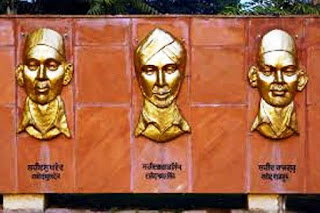
Bhagat Singh – a right time revolutionary but forgotten hero and martyrs memorial spot at Hussainiwala
Bhagat Singh and his two associates – Rajguru and Sukhdev – were the right time revolutionaries when Indians were fighting for freedom from British colonial rule over India. But they have now forgotten heroes and the National Martyrs Memorial at Hussainiwala.
Unfortunately, today on March 23, 2020, it will be the first time that Shaheedi Mela at Hussainiwala has been postponed due to lockdown in the wake pandemic Coronavirus in the whole of the country.
Bhagat Singh – born on September 27, 1907, at Banga sacrificed his life along with two close associates – Rajguru and Sukhdev and hero of the Indian the independence movement was executed in their youths on March 23, 1931, at Shadman Chowk, in Lahore, now in Pakistan.
His two acts of dramatic violence against the British in India and execution at the tender age made them the folk hero. The spot at Hussainiwala is forgotten now, erected in memory of freedom fighters and martyrs, who sacrificed their lives for their motherland.
The trios were hanged one day before the actual orders of hanging at the Lahore Central Jail fearing a revolt and secretly transported their bodies to Hussainiwala breaking the jail’s rear wall. It is also believed that they were unceremoniously set afire in the dark of the night on the banks of the Sutlej. On the next day, the residents of the area found the half-burnt bodies which they cremated after the last rites.
It took 37 years for the Indian government to raise the martyrs’ memorial but after around five decades, it has not been developed to attract the visitors, to inculcate the spirit of patriotism among them. In fact, till 1961, the memorial the spot was a part of Pakistan after partition and it was later on, exchanged with 12 villages near the Sulemanki head works in Fazilka with the initiative of first Prime Minister, Jawahar Lal Nehru.
In 1965, though the stone was laid by YB Chavan, then Union Home Minister but work could not take place due to Indo-Pak war and again in 1971 war with Pakistan, the area was attacked by Pakistan troops on the night of December 3. They looted the memorial and took away the busts of the three martyrs. These were brought back with the intervention of efforts of then DC Swaran Singh Boparai. The busts were again installed when the memorial was rebuilt in 1973 with the efforts of then CM Giani Zail Singh.
Leaders of the various subsequent governments had been visiting the place and promising to bring this spot on the international tourist map by setting up museum and light and sound show, but all promises remained a baby of the podium only.
Jaswinder Singh Sandhu, President, Shaheed Bhagat Singh Rajguru and Sukhdev Memorial Society, who organize Shaheedi Melas every year remarked that leaders come, pay floral tributes, make promises and leave which looked like a stereotyped ritual. Lastly, Narendra Modi, PM during his visit on 2015 and the subsequent visit by Navjot Singh Sidhu former Punjab Local Bodies and Tourism Minister had promised to develop the memorial and agreed to spend Rs.10 crore.
Not only this, but it’s also five years on when the notification was issued by Government of Punjab in 2015, by Anjali Bhawra, Principal Secretary, Department to of Tourism and Cultural Affairs, declaring the hide-out place of Bhagat Singh in Ferozepur, as ‘protected monument’ situated on Gaushala Road, Turi Bazar.
This building was used by Shaheed-e-Azam Bhagat Singh and other freedom fighters, built on 1150 sq. feet and ownership with Krishna Bhagti Satsang Trust. It has two shops, first shop on the ground floor is under the possession of Harish Nagar, the second shop is under the possession of Parveen Kumar and the third shop is under the possession of Raju Khattar residence of Raju Sharma on the first floor.
Rakesh Kumar, a retired officer from Railways and author of a number of books on Bhagat Singh from Ferozepur and revolutionaries of pre-partition said, Retreat Ceremony at Joint Check Post Hussainiwala and National Martyrs’ Memorial, is the only place for the visitors and relatives coming to Ferozepur. A Museum must be established like Khat Khat Kalan at Ferozepur, to put wiser the younger generation for dedicating the lives for the cause of freedom of the nation by the freedom fighters and martyrs like Bhagat Singh and his associates.
Rakesh who had a passion for writing the history of martyrs, in choking the voice said, it is very unfortunate that none of the governments since the independence of India is serious about recognizing the sacrifice of Bhagat Singh and his associates. There is a need to make the history of revolutionaries, a part of our education syllabus, who sacrificed their lives for the freedom of India, to adopt the passion of patriotism, in the generations to come.
Sat Pal Khera, President, Senior Citizens Forum opined that the government must develop the National Martyrs Memorial to make it a tourist hub to augment the spirit of patriotism among the youths and to know the sacrifices of freedom fighters to free India from British colonial rule.
Imtiaz Rashid Qureshi, an advocate by profession at Lahore High Court and Chairman, Bhagat Singh Memorial Foundation, Pakistan is fighting even after 89 years of the hanging of Bhagat Singh, Rajguru and Sukhdev to prove their innocence as the FIR written in Urdu on the basis of which they were executed, registered with the Anarkali Police Station on December 17, 1928, at 4.30 pm against two ‘unknown gunmen’. The case was registered under sections 302, 120 and 109 of Indian Penal Code at Anarkali Police Station in Lahore. Only the height of the person is mentioned as 5’-5” and appears to be Hindu on appearance from the face.
Apart from this, Qureshi is also fighting to rename the Shadman Chowk as Bhagat Singh chowk with the Pakistan government and once Pakistan the government had principally agreed but the official announcement is yet to take place.








